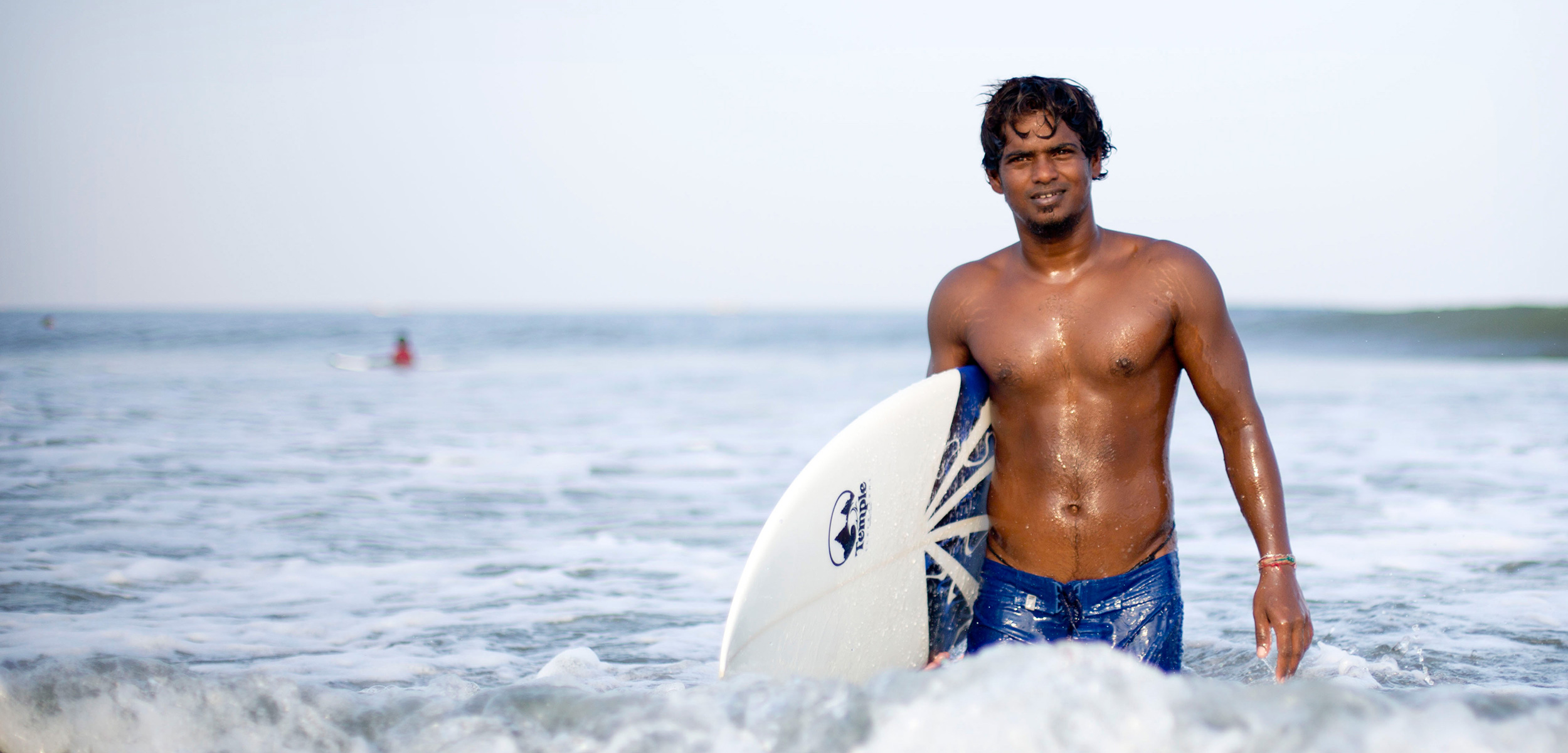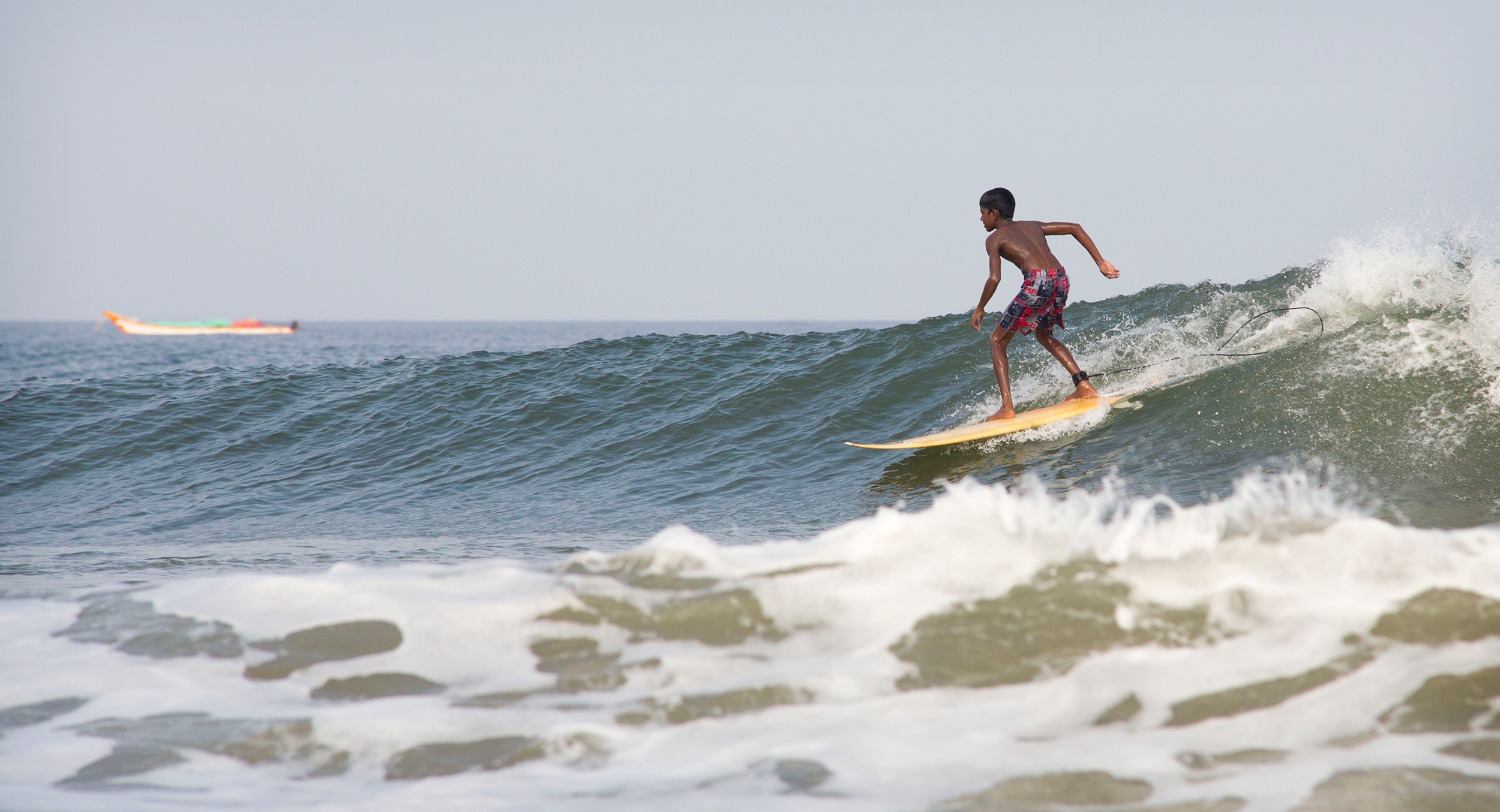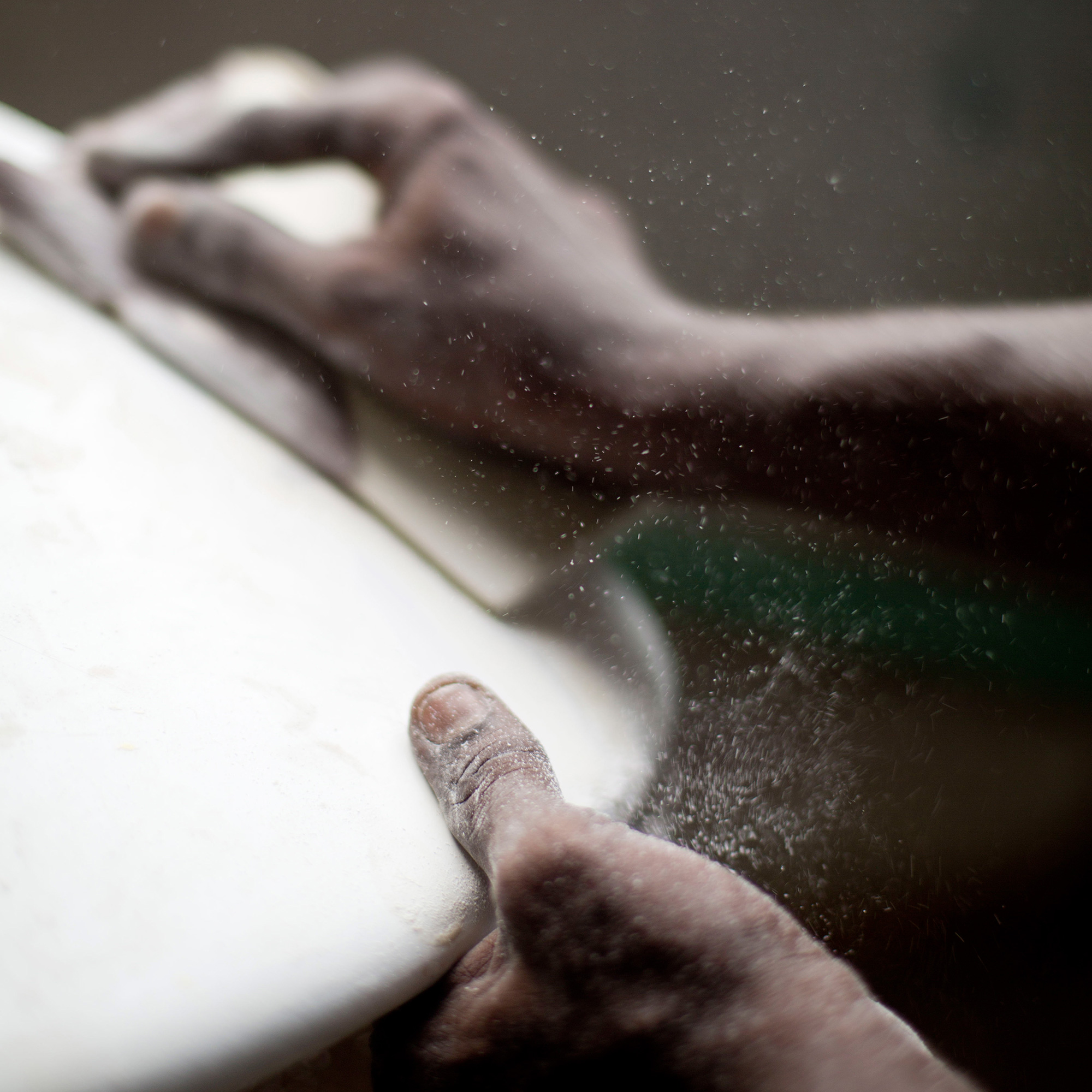The Surfing Sculptor
In Mahabalipuram, India, a fisherman turned surfer turned sculptor helps shape the region’s growing surf scene.
Article body copy
On an early April morning, the rush of the sea and the thin crackling of foam on sand are the only sounds amid the fishing boats pulled ashore on Mahabalipuram’s beach. Then, excited yelling rises on a seaward breeze. Three boys, about 10 to 12 years old, burst through a gap between the tourist restaurants and run toward the sea. They’ve come from their homes in nearby Fisherman’s Colony carrying scarred surfboards about as tall as they are. Other boys emerge from the colony’s tangled streets and soon eight tiny figures bob in the water, occasionally rising to their feet, trying to snap turns against small, neatly hollowed waves. Ten years ago, the surfers on this beach would all have been foreigners. Now, a local surf culture is growing: dozens of boys from fishing families call themselves surfers, Mahabalipuram has a surf school, and a surfboard manufacturer has just set up shop.
Strangely, these recent developments in water sports owe more than a little to the 1,300-year-old Shore Temple of Mahabalipuram, situated on a low promontory of boulders a couple of hundred meters south of the beach. The temple, the town’s tradition of stone carving, and its fishermen’s adeptness with the sea have conspired to create improbable career arcs such as that of Santhosh Moorthi, who has gone from fisherman to surfer to sculptor to India’s first surfboard shaper.
Situated on the southeastern coast of India, about 60 kilometers south of the city of Chennai, Mahabalipuram was an ancient port city that now draws tourists to see its temples. Not far from the town’s main beach are scattered the structures forming a world heritage site that UNESCO somewhat blandly calls the Group of Monuments at Mahabalipuram. The monuments, built in the seventh and eighth centuries by rulers of the Pallava dynasty, are anything but bland. Among them is a grand open-air relief, a diorama of celestial beings, humans, and animals greeting the descent of the river Ganga from the heavens to the Earth. Behind this rock face is a hillside’s worth of cave temples with tales from Hindu texts animated in stone. A couple of kilometers away, five monolithic temples, each carved in a different style, cluster around a life-sized granite elephant. By the main beach is the culmination of Pallava architecture in Mahabalipuram: the Shore Temple.
Built after the cave temples and the monoliths, the Shore Temple complex rests on bedrock and is built using quarried blocks of stone. The main shrine is dedicated to Shiva and has a densely carved, tiered pyramid rising above it, echoed by the shorter crest of an adjacent shrine. Taken together, the monuments at Mahabalipuram are significant not only for their artistic achievement but also for being among the first stone temples in southern India. Legend has it that there are even more temples under the water, lost to changing sea levels through the centuries. The Shore Temple, too, is threatened by the waves, and since the 1980s, has been protected by a groin, a wall of boulders that juts out into the Bay of Bengal. This attempt to protect the ancient temple had an unintended consequence. The breakwater created a point break, spawning the waves that surfers like Santhosh Moorthi ride and the beginnings of a local surf culture.
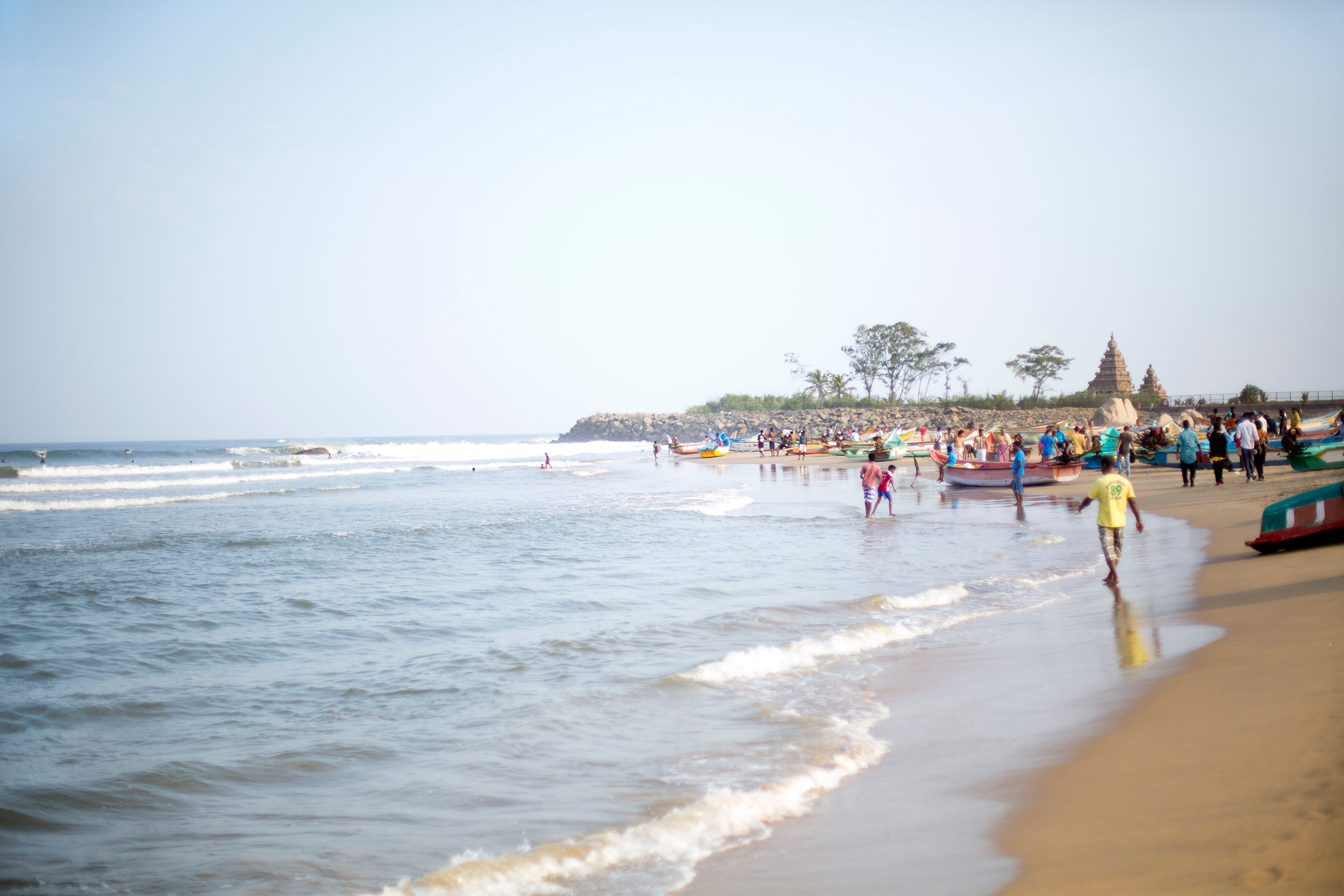
Fishing boats line the beach at Mahabalipuram, India. The groin of boulders near the iconic Shore Temple creates a point break, popular with surfers. Photo by Jyothy Karat
Santhosh is 28. He breaks into a shy smile with some regularity and speaks English with a globally-averaged accent that’s hard to place, the result of learning the language from tourists. His sentences tend to end with a “bro” or a slightly tentative “yeah.” Years ago, he picked up something else from tourists—an urge to surf. Growing up in Fisherman’s Colony, accompanying his father out to sea in the early mornings and then returning to go to school, he’d see tourists surfing near the Shore Temple. It looked like fun, he says, and so he borrowed a board and taught himself to surf in a week. His years on the water made him a natural. “I used to go fishing, so I already had the balance, yeah?”
Watching the boats enter the sea from the beach, it’s easy to see how kids from fishing families might take easily to a surfboard. The boats rear precipitously as they run up against waves, but their occupants remain nonchalant and on their feet. These days, most fishermen use boats with fiberglass bodies and outboard motors that carry up to five people. They’re painted in bright yellows, oranges, and blues, often with a pair of eyes drawn on the prow. But a simpler, older form of fishing boat, almost surely predating even the temples, is also in use—the kattumaram (the Tamil word from which the word catamaran is derived). It literally means “to tie wood,” which is exactly what it is: lengths of wood, usually five or six, bound together into an elongated raft a few meters long that can be paddled while standing, sitting, or squatting. Occasionally, Santhosh takes one out just for fun: “I love the kattumaram. It’s a good feeling. Nature on nature, the ocean, the wood.”
Soon after he started to surf, Santhosh entered a competition held in Mahabalipuram in 2011, the first of its kind in India, attended by surfers from across the country. He didn’t win, but he impressed the organizers enough that they decided to sponsor his surfing and give him a board.
One of those organizers was Dave Hearn. At a restaurant that’s become a surfers’ hangout, the bespectacled Australian explains in some detail how the waves break. On the table, his mobile phone serves as the Shore Temple; an unevenly bunched up paper napkin forms the contours of a sandbar. A mug, inadvertently knocked over, adds a touch of realism: a wave of beer surging toward the shore. Thankfully Hearn’s phone is waterproof.
“Mahabs is one of the best spots for surfing on the Indian mainland,” says Hearn. (Most surfers, including the locals, call the place by its foreshortened, tourist-friendly name.) The people he met and the allure of great surfing is why Hearn, an IT consultant, has worked remotely from Mahabs since 2007. He and a partner also own a dive school in nearby Pondicherry, and, as part of their efforts to popularize surfing, they’ve been giving surfboards to locals who want to teach others. It’s also an attempt to build an Indian market for surfing. “There are 50 to 60 local guys who surf. In all of India, perhaps a few thousand,” says Hearn. Most of them happen to be fishermen. “Fishermen weren’t taught to fear the ocean, they were taught to respect it,” says Hearn. And, as Santhosh demonstrates, it’s easier for fishermen to find balance on the water. Hearn adds, spreading wide the fingers of his hand, that the fishermen have splayed toes, which probably helps with their prodigious ability to balance barefoot. He says, “They just don’t fall off.”
With the increasing popularity of the sport, importing boards became expensive and inconvenient. So Hearn decided to be the first to manufacture boards in India and Mahabs was the perfect location—surfing was catching on and the town was teeming with craftsmen.
Santhosh was one of those craftsmen. In 2009, he tired of fishing and went to work at a cousin’s sculpture studio. (Still, the first thing he sculpted by himself was a fish.) Soon he was making stone pendants with marine motifs for tourists to buy. His cousin’s sculpture studio is one of the 300 or so such studios in Mahabs. This profusion defines the visual and sonic character of the town’s streets: workshops with stone figures overflowing onto the streets, the larger-than-life Buddhas, Ganeshas, Natarajas, elephants—sometimes even regional politicians—all in mute conference alongside the footpaths. The larger sculptures remain outside all night, being too heavy to steal. Wherever one goes on the streets of Mahabs, there’s a loose chorus of chisel meeting stone, the shriek of whirring blade against rock.
Most sculptors in Mahabs will tell you they are part of a long tradition, thriving for over a millennium, since the time of the Pallavas. It’s easy enough to imagine with the town’s famed temples and its abundance of sculptors, but J. Rajendran, the head of traditional architecture at the Government College of Architecture and Sculpture, explains that the ancient, unbroken tradition of sculpting in Mahabalipuram has been going strong only since 1957, when the college was founded. Then, as part of a recently independent India’s effort to reinvigorate traditional crafts, the government commissioned a renowned temple architect and sculptor named Vaidyanatha Sthapati to create not a temple, but a college to teach the craft. It was unlikely that much sculpture had gone on between the Pallavas and then, but the temples that remained were reason enough for Mahabs to be an inspiring location for such a college.
Graduates began to open sculpture studios in the 1960s, adding a new dimension to a settlement that then wasn’t much more than a fishing village. Young men in the region apprenticed with these studios and then started their own. The phase coincided with growing tourism that created a market. The sculpture produced today in Mahabs is broader in its iconography than the surrounding Pallava temples, and much of it is targeted at tourists or intended for export. None of the temples here are Buddhist, but the Buddha is a particularly popular subject here for being recognizable by tourists from east and west. Artisans reproduce sculpted trinkets popular on the Indian tourist circuit—pendants, latticed candle shades, elephants nested one inside the other. One sculptor blows the dust off his fingers and proudly displays the photograph of a coat of arms he made for a visiting Englishman.
Such eclecticism and experimentation may not be new to Mahabalipuram. One of the mysteries of the temples is that many of them seem unfinished or meant to demonstrate a design or pattern. “Probably the place had a school of sculpture,” says T. Satyamurthy, now retired from the Archaeological Survey of India (ASI), who has made several important excavations at Mahabalipuram. “The temples here are models,” he explains, clicking through photographs of the five monolith temples on his laptop, showing how each has a different style of temple crest and a crudely carved base. The theory that Mahabs has a long-ago association with sculpture training is intriguing, and plausible in light of how different the carvings seem to be from those seen in other temples in southern India. There’s an aspect of playfulness in Mahabalipuram that is hard to find elsewhere. Its sculptors seemed to take delight in representing the natural—a herd of elephants, deer, cattle—alongside more typical temple imagery from Hindu legends. A family of stone monkeys grooming each other, for instance, is echoed in reality when what appear to be the same monkeys play nearby on the frame of a cellular tower. Clearly, some things in Mahabs have changed very little in all these years, not least the willingness to try new things.
When Hearn gave him his first surfboard, in 2011, Santhosh carved him a stone pendant to convey his gratitude. The pendant was a miniature surfboard, fins and all. It was a sign of things to come. Hearn, who had decided to start manufacturing surfboards locally, was looking for someone to entrust with a crucial part of the process—shaping. And Santhosh was a surfer who could sculpt. Hearn recalls seeing Santhosh carving a cube of stone into a ball and thinking that here was someone who could certainly shape surfboards. Hearn and other visiting Australians trained Santhosh, who learned quickly. Hearn says, “In Australia it takes a few years to learn to make a good surfboard. These guys are quicker because of their training in sculpting and carving.” After about a year spent acquiring equipment, training staff, and honing their processes, they began producing surfboards in earnest in 2014 with Santhosh as shaper and a half dozen local surfers in other roles. The boards from Temple Surfboards, India’s first surfboard manufacturer, are now making their way to surf schools and individuals across India.
The air in the workshop of Temple Surfboards is heady with the smell of resin. It comes from upstairs, where the boards are “glassed”—given their coating of fiberglass. The front room is lined with racks holding upright boards of various sizes and colors, ready to be delivered or awaiting repairs. In the office, a battered yellow and blue surfboard is mounted on the wall—the first one made in Mahabs and very likely the first surfboard made in India. In a glass-partitioned room, a masked Santhosh stands in what looks like a field of fine snow. He’s planing a foam “blank,” the core of a surfboard, which is to the shaper what a block of stone is to the temple sculptor. He’ll shape the blank to the requirements of the board he’s making. At the moment, Santhosh is working on the rocker, or curvature, of the board’s base. Many of Temple’s boards are custom-made, and this one, he explains, is for a beginner and so is wider for stability. After Santhosh finishes shaping and sanding the foam blank, it will go upstairs to be covered in fiberglass cloth and resin. After paint and a polish, the gleaming new surfboard bearing the Temple Surfboards logo—the silhouette of the Shore Temple above a breaking wave—will be ready for a turn.
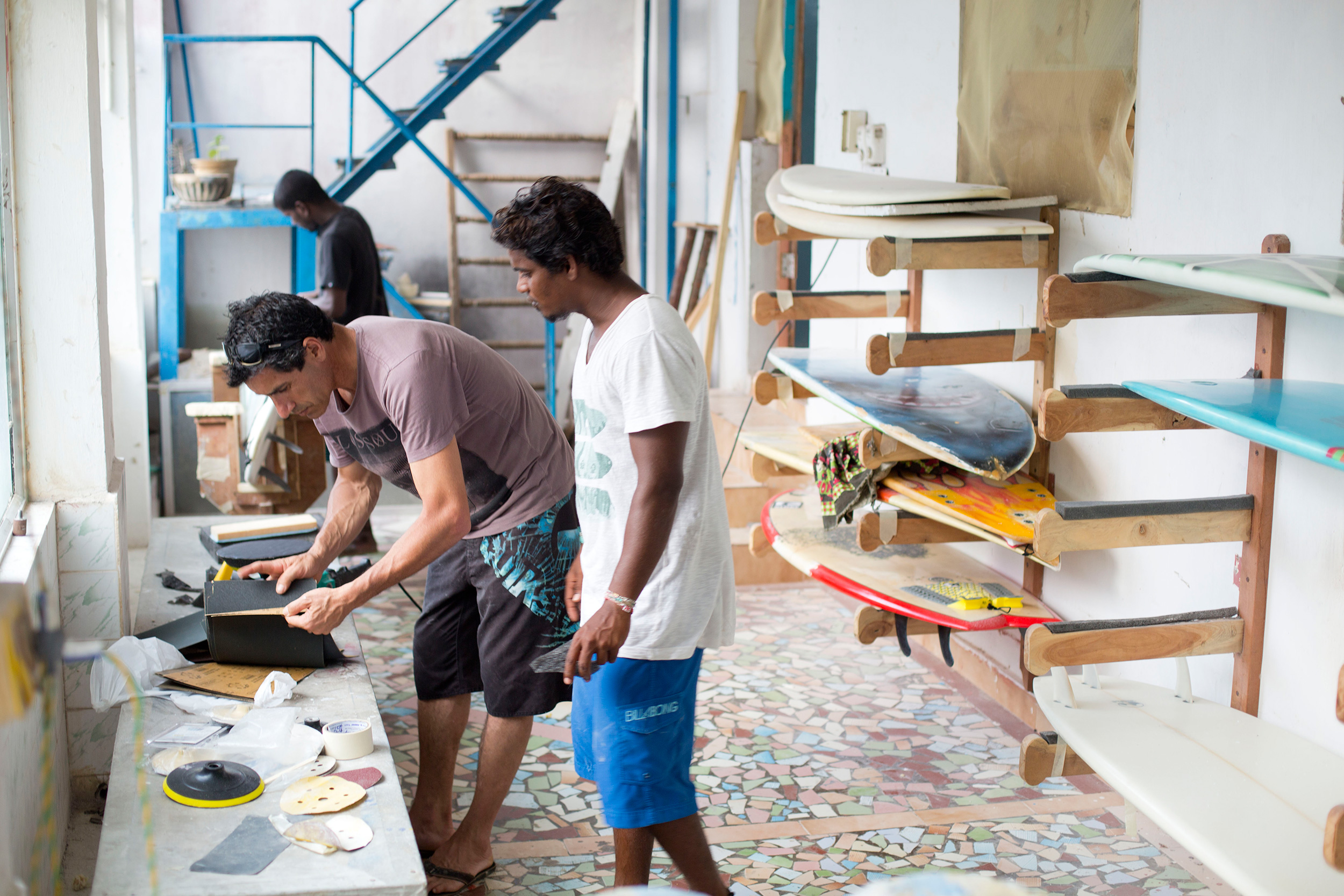
Neil Wheeler, a veteran surfboard maker from Australia, working with Santhosh Moorthi at Temple Surfboards. Photo by Jyothy Karat
Earlier this year, Santhosh married an Australian surfer, a cousin of Hearn’s, whom he met at Mahabs. He is waiting for paperwork to be complete so he can join her; it will be his first time traveling outside India. While he waits, Santhosh trains another local surfer to be a shaper in his absence. As the sport grows in India, it is not hard to imagine that these skills will be of great value. A second surfboard maker has already opened shop, at Auroville, 95 kilometers south of Mahabs.
Surfing—as a new way of relating to the familiar sea, as a means of income through making boards or giving lessons to tourists—is emerging as a source of identity and social mobility in Mahabs. Most young men in Fisherman’s Colony are now surfers at varying levels of accomplishment. Some of them compete. At least one runs a successful surf school. Some have found, as has Santhosh, that surfing can provide an exhilarating ride out of a stratified social landscape. This is true also of sculpting and tourism-related businesses, which have changed the shapes of people’s lives. Traditionally it was only members born in an artisanal group called the vishwakarma who learned how to sculpt idols. Now, sculptors in Mahabs are from diverse backgrounds. The one thing sculpting, tourism, and surfing have in common in this seaside town is that they all rose around the temples.
An inscription near what is believed to be the earliest rock-cut Pallava temple refers to its builder, Mahendravarman, as the “curious-minded king.” He was the one who thought of using stone rather than the traditional wood, brick, and metal. Clearly, the temples were meant to last, and they have. But the most curious-minded Pallava king could not have foreseen that more than a thousand years later, their temples would somehow lead to boys with surfboards gathering at sunrise to catch waves.

